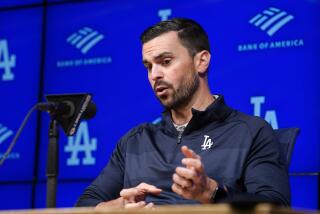Catch of the Day : After Trevor Hoffman Went to the Mound to Resurrect His Career, Marlins Were Happy to Haul Him In
When he went to lunch at the Shakey’s near his home in Anaheim one day last month, all Trevor Hoffman expected was a pizza with a chewy crust and maybe a pepperoni or two. What he got was a new outlook on his baseball life.
Hoffman, a Savanna High School graduate who played at Cypress College and the University of Arizona before being drafted by the Cincinnati Reds, got a surprise with his sausage Nov. 17.
As he and his father, Ed, watched on the pizza parlor’s TV, Hoffman was claimed by the Florida Marlins as the eighth pick in the expansion draft. It was enough to halt him in mid-bite.
“At least we didn’t have long to wait,” Hoffman said, laughing. “There weren’t too many people in there because it was a little early, around 11 a.m. One kid was in there I knew from high school. It was really strange.
“I was definitely working my way up in the Reds’ organization, but starting on the ground level with what looks like an outstanding organization is really exciting. I had no idea they were interested in me and nobody contacted me. I have to say this is a pretty good option for me.”
It’s especially good because Hoffman, 25, nearly exhausted his options in 1990.
Hoffman, the son of a longtime Anaheim Stadium employee--Ed Hoffman was renowned as “The singing usher” for his renditions of the national anthem--and brother of Marina High School basketball Coach Greg Hoffman and former major league infielder Glenn Hoffman, played shortstop in high school and college. He was chosen by the Reds as a shortstop in the 11th round of the 1989 draft, but he realized after hitting .212 for Class A Charleston (W.Va.) in 1990 that his bat wasn’t going to get him to the major leagues. That made him amenable when the Reds suggested he put his arm to better use on the pitching mound.
“Thank goodness somebody had enough smarts and patience to turn him into a pitcher,” said Scott Pickler, Hoffman’s coach at Cypress and a staunch admirer of Hoffman’s athletic talent and character. “He had the moxie to make the change, and being around the game, he had the knowledge to do it.
“We tried to put him on the hill here. We gave him a couple of bullpens (throwing sessions) before. He threw that great fastball but it was straight, and he was rocked. I think it went double, double, single, home run, and I came to the mound and said, ‘I think you’ve had enough.’ He said, ‘I think so, too.’ ”
The Marlins are glad Hoffman didn’t get discouraged. Impressed with his overpowering fastball, they figure Hoffman can eventually be their closer, and that timetable could be accelerated if Bryan Harvey needs more time to recover from the elbow operation he underwent last August while Harvey was pitching for the Angels.
“Our scouts saw him pitch and liked his arm. He’s got tremendous arm strength,” Marlin General Manager Dave Dombrowski said of Hoffman. “He’s also a pitcher who’s not afraid to challenge hitters. He projects to be a closer for us. We know he has started but we look at him to help us in the bullpen.”
Hoffman began to show pitching promise in 1991, compiling a 1-1 record, a 1.87 earned-run average and 12 saves in 27 games with Cincinnati’s Class A team in Cedar Rapids, Iowa. Promoted to double-A Chattanooga (Tenn.) later that season, he was 1-0 with a 1.93 ERA and eight saves in 14 games.
Hoffman opened the 1992 season with Chattanooga as a starter, another switch. With the determination Pickler said typifies Hoffman’s approach to the game, Hoffman adapted as well to starting as he had to relieving. He was 3-0 with a 1.52 ERA in six starts for Chattanooga and started five times after his promotion to triple-A Nashville. Overall, his Nashville record was 4-6 with a 4.27 ERA and six saves in 42 games.
“I went into spring training with tendinitis in my shoulder and (Reds executives) felt it was a sign I needed to build some arm strength,” Hoffman said. “Once I got some innings under my belt, I felt good. I felt I did pretty well as a starter, then right before I was ready to go back to the pen, I had a five-run inning. (His ERA) was on the verge of the low 2.00s and went to the high 4.00s. In the pen it’s difficult to make your ERA do anything but go up because you’re not getting a lot of innings.
“I learned a lot. I don’t want to get too caught up in numbers but I felt I got things accomplished as far as the mental aspect of the game.”
Although he accomplished so much last year, Hoffman still has work to do.
“His fastball is his main pitch, and he needs to get better command and other pitches,” Dombrowski said. “If he was to break in with us, it would be gradual. A lot depends on what happens in spring training with him and with Bryan Harvey. We’ve also got Jim Corsi and Cris Carpenter as setup men.”
Hoffman acknowledges he has much to learn.
“Nobody thinks their stuff is perfect, but I definitely need another pitch. That’s how I got in trouble in triple A, not being able to go to another pitch,” said Hoffman, whose repertoire also includes a slider, a curveball and a changeup.
“What would I go to after my fastball? It depends on what role I’m in. You don’t want to go out and get beat with your fourth-best pitch. When I was starting last year, I was using the majority of my pitches. If I’m a setup guy or closer it depends on what I’ve thrown recently and what I’m throwing well before I get in there.”
Hoffman thought he was pitching well enough in Nashville to merit a promotion to the major leagues, but he didn’t sulk when the Reds passed him over.
“I was pretty happy with how things went. I would have liked to go up in September, but they looked at my performance in triple A and said I wasn’t ready, and they didn’t want to shoot my confidence. They left me there and sent me to the instructional league,” said Hoffman, who spent six weeks in Plant City, Fla., the Reds’ spring training site. “I wanted to get back in their good graces and show I was willing to do whatever it takes. I got some innings under my belt and I felt good about it.”
He’s delighted with the prospect of being part of the Marlins’ inaugural season, despite predictions the team will struggle. Unlike the Colorado Rockies, whose expansion picks leaned toward experienced players, the Marlins took many youngsters who lack major league experience.
“A lot of people have talked about the idea of an expansion team needing a closer or not. I think we’re going to be pretty competitive this year, and if not, within a few years,” Hoffman said.
“I have no idea what’s going to happen as far as where I fit in. Anything the Marlins feel like doing is fine with me, as long as I get an opportunity to prove myself on the big-league level. Something like 17 of their picks were pitchers, so I don’t know how things will shape up. I do know I definitely need to worry about Trevor Hoffman and not about anybody else.”
His only other worry is whether his relatives will root for his new team. Some of them might occasionally refuse to don the teal, black and silver Marlin caps--but they have a good excuse.
“There’s definitely a Dodger contingent because of my brother, who was just named manager in double-A San Antonio,” Hoffman said of Glenn, who is 10 years his senior. “I think there will be some Marlin caps in the bunch.”
More to Read
Go beyond the scoreboard
Get the latest on L.A.'s teams in the daily Sports Report newsletter.
You may occasionally receive promotional content from the Los Angeles Times.











